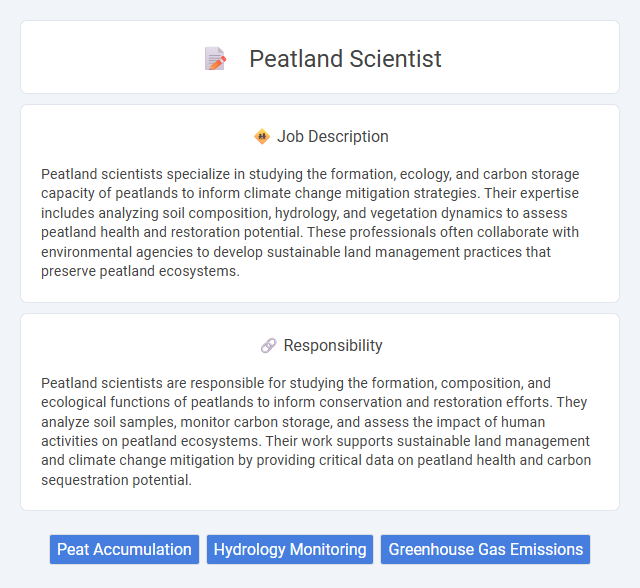
Peatland scientists specialize in studying the formation, ecology, and carbon storage capacity of peatlands to inform climate change mitigation strategies. Their expertise includes analyzing soil composition, hydrology, and vegetation dynamics to assess peatland health and restoration potential. These professionals often collaborate with environmental agencies to develop sustainable land management practices that preserve peatland ecosystems.
Individuals with a strong interest in environmental science and a willingness to conduct fieldwork in challenging, often remote and wet conditions are likely suitable for a peatland scientist role. Those who can adapt to variable weather, possess patience for long-term ecological studies, and have an aptitude for analyzing soil and water data probably fit well in this position. Candidates lacking physical stamina or interest in detailed environmental research might find this job less suitable.
Qualification
A Peatland Scientist typically requires a degree in environmental science, ecology, geology, or related fields, with advanced qualifications such as a master's or Ph.D. preferred for research roles. Expertise in peatland ecology, hydrology, carbon cycling, and soil science is essential, alongside proficiency in fieldwork techniques and geospatial data analysis. Strong analytical skills, experience with environmental monitoring and restoration projects, and knowledge of climate change impacts on peatlands enhance career prospects in this specialized field.
Responsibility
Peatland scientists are responsible for studying the formation, composition, and ecological functions of peatlands to inform conservation and restoration efforts. They analyze soil samples, monitor carbon storage, and assess the impact of human activities on peatland ecosystems. Their work supports sustainable land management and climate change mitigation by providing critical data on peatland health and carbon sequestration potential.
Benefit
Peatland scientists likely contribute significantly to climate change mitigation by studying carbon storage and sequestration in peat bogs, which may help reduce greenhouse gas emissions. Their research probably supports conservation efforts and sustainable land management, promoting biodiversity and ecosystem health. By providing data for environmental policy, they could enhance protection strategies for critical wetland habitats, benefiting both local communities and global ecosystems.
Challenge
Peatland scientists likely face challenges related to accurately assessing carbon storage and greenhouse gas emissions in complex, water-saturated ecosystems. The unpredictable impact of climate change on peatlands may complicate efforts to develop effective conservation strategies and restoration techniques. Limited accessibility and varying peatland conditions could also hinder field research and data collection, increasing the difficulty of producing reliable results.
Career Advancement
Peatland scientists specialize in studying and managing peat ecosystems, crucial for carbon storage and climate regulation, with career advancement often linked to expertise in environmental research and sustainable land use practices. Opportunities for growth include leadership roles in academic research, governmental environmental agencies, and private sector consultancy focusing on peatland conservation and restoration projects. Advancing in this field typically requires interdisciplinary skills in ecology, soil science, and remote sensing, alongside strong publication records and collaboration with policy makers.
Key Terms
Peat Accumulation
Peatland scientists specializing in peat accumulation analyze the rates and processes of organic matter build-up in wetland ecosystems to understand carbon sequestration dynamics. These experts utilize field sampling, radiocarbon dating, and remote sensing technologies to measure peat layer thickness and composition over time. Their research supports climate change mitigation by quantifying peatlands' role as significant long-term carbon sinks.
Hydrology Monitoring
Peatland scientists specializing in hydrology monitoring analyze water flow, saturation levels, and groundwater interactions within peat ecosystems to assess carbon storage and ecosystem health. They use advanced hydrological instruments such as piezometers, water level loggers, and remote sensing technologies to collect precise data on moisture dynamics. These insights inform conservation strategies and restoration projects aimed at preserving peatland biodiversity and mitigating climate change impacts.
Greenhouse Gas Emissions
Peatland scientists specializing in greenhouse gas emissions analyze carbon fluxes from peat soils to understand their impact on climate change. They employ field measurements and remote sensing technologies to quantify methane and carbon dioxide emissions, crucial for developing mitigation strategies. Their research informs global efforts to preserve peatlands as vital carbon sinks and reduces atmospheric greenhouse gases.
 kuljobs.com
kuljobs.com